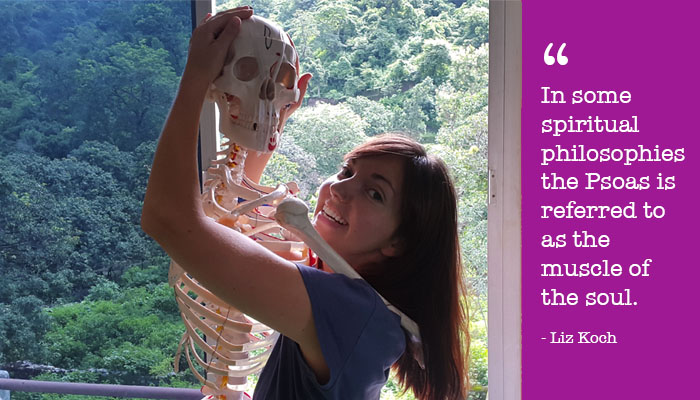When I’m being taught yoga, I love it when a teacher succinctly describes why we’re focusing on a particular part of our bodies. For example, rather than saying, we’re strengthening the soleus muscle, they instead would say why this is important, or give a quick benefit that’s easy to relate to.
The muscle of the soul
A few weeks ago, I read this article The Psoas: Muscle of the Soul which my yoga anatomy & physiology teacher in India recommended. It really transformed my view of learning anatomy and physiology in the context of yoga.
The article references teacher and author Liz Koch who has spent 30 years specialising in one just one muscle — the psoas, which is referred to throughout the article as the muscle of the soul.
I’m not going to go into depth about the psoas here, but my point is that after I finished reading the article, I was fascinated and decided to find out more about this muscle. I’m not going to take everything I read as fact, but what this article did for me is create a story around the muscle and open me up to a new way of looking at the human body. As a result, I was able to memorise other facts about this muscle and related parts of the body much more easily.
How I’m deepening my anatomy and physiology knowledge for yoga
To deepen my own knowledge of anatomy and physiology I’ve, therefore, started a new project which involves selecting a part of the body that interests me and then focusing predominantly on that part — finding out as much as I can, whilst at the same time relating it back to relevant asanas and yoga philosophy.
I feel that without a doubt, when I was revising the origin and insertions for different muscles on my previous course and memorising a lot of other facts, finding stories or even nicknames for parts of the body would have really helped.
The soleus, for example, is sometimes referred to as the second heart because it helps to pump blood back from the lower legs and feet to the heart. And the gastrocnemius is often referred to as the stomach of the leg because of the origin of the word.
I know everyone learns differently, but for me, this is a really exciting way of learning a subject I have previously struggled with, and I discover things that I had no idea about.
Yesterday, for example, I started to look into the pineal gland. You’re often told that practising inversions such as Sarvangasana (Shoulderstand) or Sirsasana (Headstand) help to stimulate the pineal gland, but how does that relate specifically to the person practising? And what would I want to know about the pineal gland in relation to my own practice and life?
When I started to look into this part of the Endocrine system beyond what I’d revised for in previous exams, I was really blown away, especially after reading that the pineal gland could be related to consciousness — just an idea!
What next?
It got me thinking that maybe kundalini energy and the nadis could exist at a deeper level too. Before I came out to India, I started to read a book called Yoga: Fascia, anatomy and movement. I haven’t finished it yet, but this book began to open me up to a completely new way of viewing the body too.
I understand that I’m reading theories as well as facts, but some of these theories are really helping me to learn and perhaps there are more direct connections than we think there are between yoga philosophy and modern anatomy and physiology.
If you’ve got any more tips for learning anatomy and physiology, please feel free to share them in a comment below.

